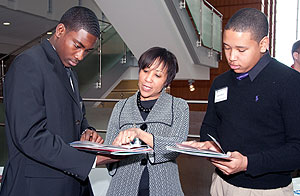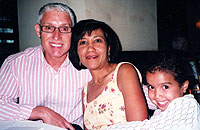Lisa Stevenson joined the Office of Diversity Programs one year after its formation. In Stevenson, Will Ross, M.D., associate dean for diversity, found someone who shared his vision.
Stevenson knew she had made the right decision from the beginning.

“I met some great students and felt like it was a privilege to interview them,” Stevenson says. “I also liked being part of a small but vital part of the medical school.”
Whether she’s recruiting underrepresented students or organizing the Saturday Scholars public high-school outreach program, colleagues say Stevenson is organized and has high standards and an attitude of “get it right the first time.” She was named director of the diversity programs office in 2006.
Ross took on the challenge of promoting racial diversity at the School of Medicine in 1996. His first order of business was to change the name of his department from Office of Minority Affairs to Office of Diversity Programs. Almost immediately, students of all races started knocking on the door, wanting to learn more about this new resource.
Ross’ vision was not only to recruit minority students but also to change the overall medical school environment. He wanted minority students to feel a degree of camaraderie with each other and feel like a part of the greater student body.
He also believed a successful physician must have the ability to relate to all of his or her patients and community, and that these skills can only come through an understanding and acceptance of the broad range of beliefs and cultural practices in society.
“Increasing the number of underrepresented students at the medical school and building a more diverse physician workforce are also dreams of Lisa’s,” says Ross, also associate professor of medicine. “Additionally, she sees herself as a role model and mentor to students of color.”
Firsthand experience

Stevenson knows what it feels like to be in the minority in school situations.
During her childhood, Stevenson’s father, a middle-school principal, and her mother, a kindergarten teacher, emphasized education. Her parents sent Lisa and her brother and sister to private schools in St. Louis — Community School and John Burroughs School.
“I had two black classmates at Community School and was one of a handful of black classmates at John Burroughs,” Stevenson says.
When she applied to colleges from her North St. Louis home, Harvard was her “reach” school. A year later, she moved to Cambridge, Mass., to begin her freshman year.
“I had no idea what I was getting into,” Stevenson says. “I met people from totally different backgrounds, and the lecture halls were very large and impersonal.”
She also ran into many students from the East Coast who knew little, if anything, about St. Louis or the Midwest.
Eventually, she made a group of friends, adjusted to dorm life and found her place among the large student body. She earned a bachelor’s degree in psychology, planning to land a job in marketing.
“It was an exciting day for my family,” Stevenson says.
A good fit
|
Lisa Stevenson |
|
Hometown: St. Louis Education: B.A., Harvard University; MBA, Washington University Title: Director, Office of Diversity Programs Recent books she has read: “Dreams from My Father” and “The Audacity of Hope,” both by President Barack Obama Family: Husband, Jeffrey; and daughter, Nia |
But after working in St. Louis as a marketing analyst at Citicorp for a few years, she realized that she didn’t want a job crunching numbers.
In 1987, she earned a master’s in business administration from Washington University through a fellowship from the Consortium for Graduate Study in Management. This organization fosters diversity and inclusion in American business.
She then worked in human resources at a number of St. Louis companies before joining the University’s Office of Undergraduate Admissions as associate director and coordinator of multicultural recruitment in 1994. In the position, she traveled the country, talking to high-school students and guidance counselors and reviewed thousands of applications.
“This job was a good fit for me,” she says. “I enjoyed marketing Washington University to talented high-school students and their families.”
“When our office was created, there was a critical need to weave our programs seamlessly with our recruitment efforts in order to maximize both efficiency and exposure,” Ross says. “Lisa’s stellar academic background and her business training provided her with the skill set she needed to retool our operations and focus more effectively on outcomes.”
Each year, about 10 percent to 12 percent of medical students are from underrepresented groups. They want to see students who look like them and to feel like they’ll be part of the community, Stevenson says. Having some contact with minority faculty also is important.
Stevenson developed an alumni database and a student/faculty directory to make networking opportunities easier among students, residents, fellows, faculty and alumni from underrepresented groups.
“Once students get here, they want to see even more students of color and want to get involved in recruitment, student fairs and making phone calls to accepted students,” she says.
Since Stevenson became a part of the diversity programs office, its scope has broadened beyond recruitment and student outreach efforts. The office now organizes more social events for current students and has programs that are open to everyone, including students from disadvantaged socioeconomic backgrounds who aren’t members of underrepresented groups.
Stevenson also is involved in curriculum. Each year, she helps the second-year students organize a voluntary diversity retreat for all first-year students. At the retreat, students review how to treat someone whose background is different from theirs. The retreat is popular, with more than 80 percent of first-year students participating in the overnight experience.
Rosa DaSilva, program coordinator for recruitment and multicultural affairs at Harvard University Medical School, met Stevenson in the late 1990s.
“We have stayed in touch and collaborated ever since,” DaSilva says. “She is an extremely bright, energetic and diplomatic administrator. I think of her as the pillar of the office, a constant figure who guides her students gently.”
Medical students who work with Stevenson also praise her communication skills.
“What first struck me about Mrs. Stevenson was that she has a way of making people instantly feel comfortable around her,” says Guguamobi Okafor, a first-year medical student. “She’s very open and supportive — students can talk to her about anything, and she takes our concerns seriously and helps in any way she can.”
Stevenson also plays a key role in admissions, chairing the Western Region medical school admissions subcommittee, which reviews and processes applications from an eight-state region.
A diligent recruiter
W. Edwin Dodson, M.D., associate vice chancellor and associate dean for admissions and for continuing medical education, says Stevenson is an outstanding ambassador for the medical school.
“A diligent and intrepid recruiter, Lisa knows the school inside and out, and she projects the warm sense of community, excitement of discovery, community engagement and opportunities for personal fulfillment that set our environment apart,” he says.
When Stevenson is evaluating applications and conducting interviews, she says she’s looking beyond academics for empathy and a dedication to something important to the student. One student was a varsity wrestler who also found time to work for a homeless shelter.
Additionally, Stevenson takes four to six trips each year to college fairs and medical exposure programs to promote the School of Medicine and to work toward increasing the racial and ethnic diversity within the student body at the medical school.
Koong-Nah Chung, Ph.D., assistant dean for medical admissions and student affairs, says Stevenson is a wonderful colleague — smart, focused and committed to making the medical school’s diversity program a priority.
“I also admire her for balancing work with her home life,” she says.
Stevenson is married to Jeffrey Stevenson, who works for the Metropolitan St. Louis Sewer District. Her sister set them up on a blind date. The couple has a 6-year-old daughter, Nia, who is following in her mom’s footsteps at Community School.
In her spare time, Stevenson escorts her daughter to play dates, dance classes and soccer games. Stevenson makes time to exercise and enjoys yoga and spinning classes at a local gym. She also likes to read nonfiction and contemporary design or interior design magazines.
The family vacations in St. Petersburg, Fla., and Stevenson and her husband like to hear jazz at The Pageant and Jazz at the Bistro.
Stevenson says she’s often inspired by the students she recruits and works with, many of whom overcome great obstacles to get to medical school.
Some students leave their home country and families to fulfill their dreams of becoming a physician, and others have to learn English while immersing themselves in their first-year studies.
“I think it’s crucial to look at the distance these students have traveled to get to this point,” she says.